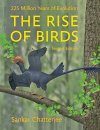About this book
Knowledge of the evolutionary history of birds has much improved in recent decades. Fossils from critical time periods are being described at unprecedented rates and modern phylogenetic analyses have provided a framework for the interrelationships of the extant groups. Avian Evolution gives an overview of the avian fossil record and its paleobiological significance, and it is the only up-to-date textbook that covers both Mesozoic and more modern-type Cenozoic birds in some detail. The reader is introduced to key features of basal avians and the morphological transformations that have occurred in the evolution towards modern birds. An account of the Cenozoic fossil record sheds light on the biogeographic history of the extant avian groups and discusses fossils in the context of current phylogenetic hypotheses. This review of the evolutionary history of birds not only addresses students and established researchers, but it may also be a useful source of information for anyone else with an interest in the evolution of birds and a moderate background in biology and geology.
Contents
FOREWORD
PREFACE
ACKNOWLEDGEMENTS
1. AN INTRODUCTION INTO BIRDS, THE GEOLOGICAL SETTINGS OF THEIR EVOLUTION, AND THE AVIAN SKELETON 4
Birds are evolutionary nested within theropod dinosaurs 4
The geological settings of avian evolution in a nutshell 6
Characteristics of the avian skeleton 7
2. THE ORIGIN OF BIRDS 13
Archaeopteryx: The German “urvogel” and its bearing on avian evolution 13
The closest maniraptoran relatives of birds 15
Feather evolution 21
The origin of avian flight 25
3. THE MESOZOIC FLIGHT WAY TOWARDS MODERN BIRDS 29
Jeholornithids: Early Cretaceous long-tailed birds 30
Confuciusornis, Sapeornis, and kin: Basal birds with a pygostyle 31
Ornithothoraces and the origin of sustained flapping flight capabilities 34
The Ornithuromorpha: Refinement of modern characteristics 37
Ornithurae and the origin of modern birds 40
4. MESOZOIC BIRDS: INTERRELATIONSHIPS AND CHARACTER EVOLUTION 43
The interrelationships of Mesozoic birds – controversial phylogenetic placements and well-supported clades 43
Character evolution in Mesozoic birds 45
Ontogenetic development of Mesozoic birds 53
5. THE INTERRELATIONSHIPS AND ORIGIN OF CROWN GROUP BIRDS (NEORNITHES) 55
Phylogenetic interrelationships of neornithine birds 56
The Mesozoic fossil record of neornithine-like and neornithine birds 58
6. PALAEOGNATHOUS BIRDS (OSTRICHES, TINAMOUS, AND ALLIES) 61
The interrelationships of extant Palaeognathae 62
Early Cenozoic palaeognathous birds of the Northern Hemisphere 63
The long-winged ostriches, rheas, and tinamous 64
The short-winged palaeognathous birds 67
Biogeography: A textbook example of Gondwanan vicariance has become dismantled 70
7. GALLOANSERES: “FOWL” AND KIN 71
Galliformes – from herbivorous forest dwellers to seed eaters of open landscapes 72
The waterfowl 75
Gastornithids: Giant herbivorous birds in the early Paleogene of the Northern Hemisphere 79
Dromornithids (mihirungs or thunderbirds): Gastornis-like birds from Australia 80
Pelagornithids: The bony-toothed birds 81
8. THE “DIFFICULT-TO-PLACE GROUPS”: BIOGEOGRAPHIC SURPRISES AND AERIAL SPECIALISTS 83
The columbiform birds: Doves, sandgrouse, … and mesites? 84
The Hoatzin – a South American relict species 85
Turacos and cuckoos 86
Bustards 87
The “wonderful” Mirandornithes, or how different can sister taxa be? 88
Strisores: The early diversification of nocturnal avian insectivores 91
9. SHOREBIRDS, CRANES, AND RELATIVES 97
Charadriiformes: One of the most diverse groups of extant birds 97
From rail to crane 103
10. AEQUORNITHES: AQUATIC AND SEMI-AQUATIC CARNIVORES 107
Loons: Foot-propelled divers of the Northern Hemisphere 107
The pelagic tubenoses and albatrosses 108
Penguins: More than 60 million years of flightlessness 111
The polyphyletic “Pelecaniformes” and “Ciconiiformes” 115
Late Cenozoic turnovers in marine avifaunas 125
11. CARIAMIFORMS AND DIURNAL BIRDS OF PREY 126
Seriemas and allies: Two species now, a lot more in the past 127
Diurnal birds of prey: Multiple cases of convergence among raptorial birds 131
12. THE CENOZOIC RADIATION OF SMALL ARBOREAL BIRDS 137
The Courol and mousebirds: Two African relict groups 137
The long evolutionary history of owls 140
Parrots and passerines: An unexpected sister group relationship and its potential evolutionary implications 142
Trogons, rollers, and woodpeckers: Cavity-nesters with diverse foot morphologies 148
13. INSULAR AVIFAUNAS NOW AND THEN, ON VARIOUS SCALES 153
Islands and isolated continents as refugia 154
The evolution of flightlessness in predator-free environments 155
Insular gigantism and islands as cradles of unusual morphologies 160
GLOSSARY 163
REFERENCES 165
INDEX
Customer Reviews











































